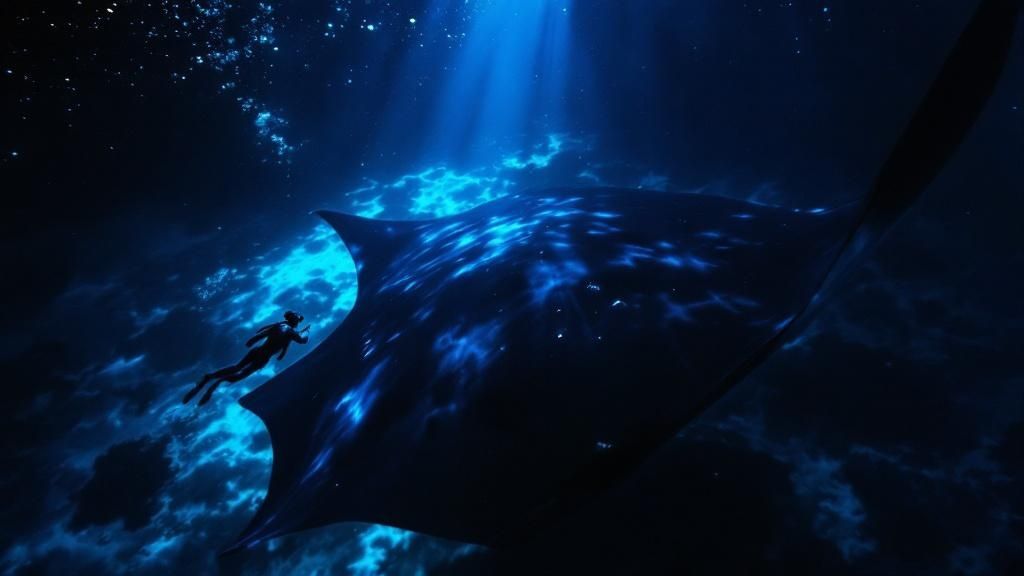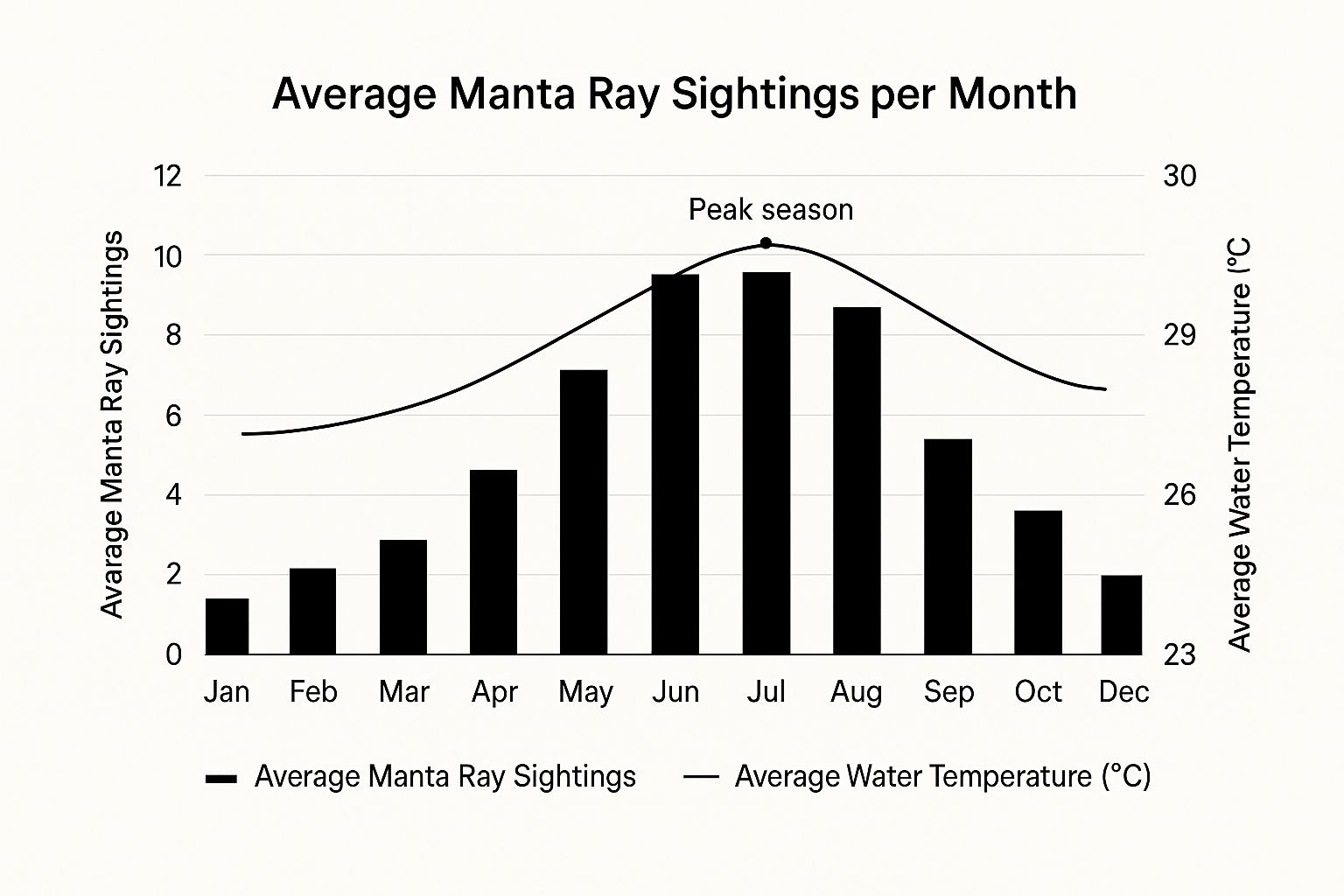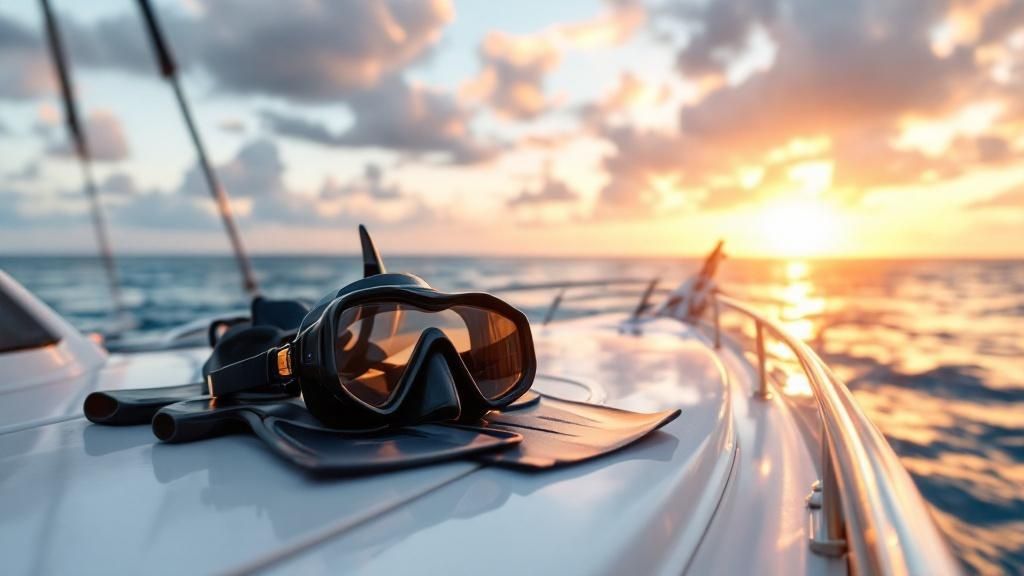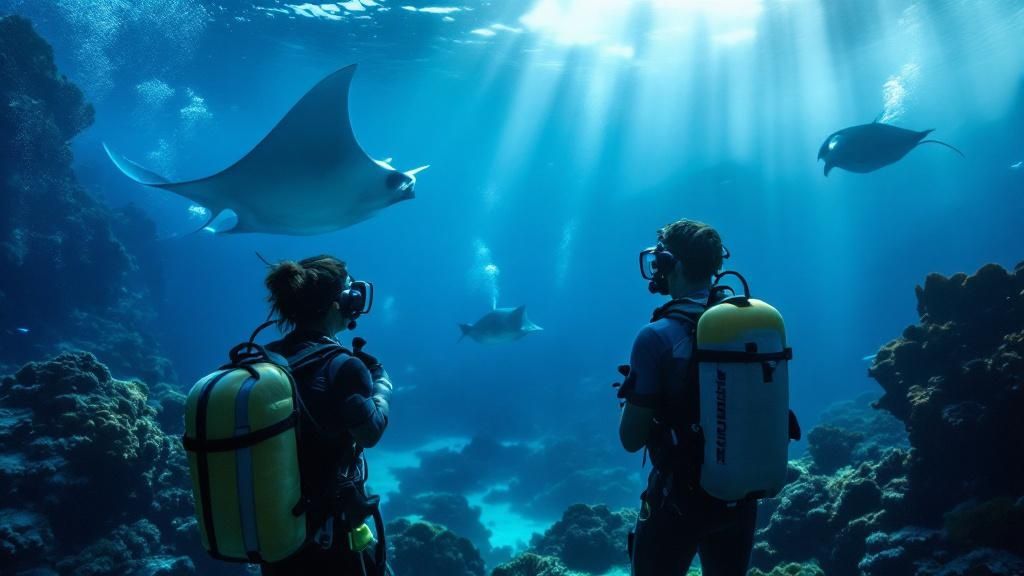Manta Ray Snorkel Kona: Ultimate Guide to Hawaii’s Top Experience
- Byron
- Jun 2, 2025
- 13 min read
Why Kona Offers The World's Best Manta Ray Encounters
Kona, Hawaii, isn't just a stunning tropical getaway; it's a haven for manta rays. Several factors combine to make this volcanic coastline a paradise for these gentle giants, drawing in snorkelers and marine biologists alike. The magic lies in the unique interplay of geography, ocean currents, and a flourishing ecosystem.
The Perfect Recipe for a Manta Ray Hotspot
The Big Island's volcanic slopes play a crucial role. Plunging deep into the Pacific, these slopes create nutrient-rich upwellings. These upwellings, in turn, fuel massive plankton blooms. Plankton is the cornerstone of the manta ray diet, like a giant, constantly replenished underwater buffet. This consistent food source is a key reason why manta rays are year-round residents of Kona.
The underwater topography also contributes to Kona's allure. Specific areas, like Manta Village and Manta Heaven, act as natural funnels, concentrating plankton near the surface. This predictable food supply creates reliable aggregation sites for the mantas. This makes Kona a dependable location for manta ray snorkel adventures. This predictability also translates to remarkably high sighting rates. In fact, 80% to 90% of snorkelers encounter these majestic creatures on their trips. This impressive success rate is due to the unique nighttime viewing conditions and the presence of a large resident manta ray population. Find more detailed statistics here.
A Thriving Resident Population
Unlike many locations with seasonal manta ray sightings, Kona boasts a year-round resident population. This population isn't just large; it's also well-studied. Researchers have identified hundreds of individual manta rays, each with unique markings for long-term tracking. This ongoing research provides invaluable insights into manta ray behavior, migration patterns, and population dynamics.
This research not only benefits our understanding of these creatures but also enhances the snorkeling experience. Tour operators use this knowledge to understand manta ray behavior and predict their movements, creating richer, more meaningful encounters for snorkelers. Interested in maximizing your experience? Learn more about how to master your Kona manta ray snorkel adventure.
More Than Just a Meal: The Nighttime Spectacle
While manta rays are visible during the day, the nighttime experience sets Kona apart. Under the cover of darkness, specialized lights used by tour operators attract plankton, creating a mesmerizing feeding frenzy. These lights, strategically positioned near the surface, mimic the natural bioluminescence that attracts plankton, drawing in the mantas.
Imagine floating in the dark ocean, gentle waves lapping against you. Suddenly, a giant manta ray emerges from the darkness, its wingspan breathtakingly wide. It glides through the illuminated water, performing acrobatic loops as it feeds on the concentrated plankton. It's a truly unforgettable, ethereal underwater ballet. This unique nighttime viewing experience, combined with reliable sightings and ongoing scientific research, makes Kona a global leader for manta ray encounters.

Discovering Kona's Premier Manta Ray Hotspots
Kona, Hawaii, is famous for its incredible manta ray snorkeling. Two popular spots, Manta Village and Manta Heaven, both offer magical encounters. However, choosing the right location depends on several factors. Experienced tour operators consider water conditions, seasonal patterns, and manta ray behavior to select the best spot each night, catering to various skill levels and preferences.
Understanding Location Dynamics
Manta Village, located off the coast near the Sheraton Kona Resort, is known for its shallow depth of around 30-40 feet. This makes it easier for beginners to snorkel comfortably. The gently sloping bottom contributes to plankton build-up, attracting manta rays. Its proximity to the coast often results in calmer waters.
Manta Heaven, further offshore near Kona International Airport, provides a different experience. Its slightly deeper waters, around 45-50 feet, and a more varied underwater landscape with coral bommies and small canyons, attract diverse marine life. While the depth might require a bit more snorkeling experience, it can also lead to larger manta ray gatherings, sometimes exceeding 20-30 individuals in a single night. The choice often comes down to personal comfort and the desired experience.
Decoding Seasonal and Environmental Influences
Several factors influence the best location choice. Water clarity is crucial, and operators will choose the spot with better visibility, which can fluctuate due to recent rainfall, currents, and plankton density. Wind and wave conditions also play a role, especially during the winter months (November-March) when rough seas can make some spots inaccessible. Strong southerly swells might make Manta Heaven less suitable for snorkeling, while Manta Village remains protected.

The infographic above shows average manta ray sightings per month and average water temperature. While manta rays are present year-round, peak sightings often occur during warmer water temperatures and calmer seas in the summer months (June-August). Consider seasonal changes when planning your manta ray snorkel kona trip.
Moon phases and tidal patterns also affect manta ray behavior. During a new moon, reduced ambient light enhances the underwater lights used to attract plankton, creating dramatic feeding displays. Incoming tides often bring fresh plankton, potentially increasing manta ray activity. Understanding these relationships helps operators make informed decisions for a great encounter.
To help you choose the best location for your experience, take a look at this comparison table:
Kona Manta Ray Location Comparison Guide: Complete breakdown of premier manta ray sites including conditions, typical encounters, and optimal timing
Location | Water Depth | Typical Manta Count | Ideal Conditions | Success Rate |
|---|---|---|---|---|
Manta Village | 30-40 feet | 5-15 | Calm seas, good visibility | High |
Manta Heaven | 45-50 feet | 10-30+ | Calm to moderate seas, good visibility | High |
This table highlights the key differences between the two locations, helping you choose the best spot based on your experience and desired encounter size. While both locations offer great chances of seeing manta rays, Manta Village is generally better for beginners due to shallower depths and calmer conditions, while Manta Heaven offers the potential for larger groups of manta rays.
Maximizing Your Encounter: Choosing the Right Time
Both Manta Village and Manta Heaven offer incredible experiences. Choosing the right time based on your experience and preferences is key. Manta Village, with calmer waters and shallower depths, is ideal for beginners and families. This provides a comfortable introduction to night snorkeling and good chances of close encounters.
Manta Heaven, with its slightly greater depth and potential for larger manta ray gatherings, often appeals to more experienced snorkelers. Those comfortable with deeper water and longer swims might find Manta Heaven more thrilling. Considering your comfort level and desired experience, along with the current conditions, will help you select the best spot for an unforgettable manta ray snorkel kona adventure.
Inside Your Manta Ray Snorkel Kona Experience
So, you've chosen Kona for your manta ray encounter and picked your ideal spot. What awaits you as you slip into the dark Hawaiian waters? It's more than just a snorkel; it's a multi-sensory journey that begins with the anticipation of the boat ride to sites like Manta Village or Manta Heaven.
Setting the Stage: Arrival and Preparation
As you approach the snorkel site, the crew will brief you on safety protocols and the etiquette of observing manta rays. This covers how to position yourself and avoid disturbing these gentle giants. You'll likely put on a wetsuit and be given a flotation device, often a pool noodle, to help you maintain a comfortable horizontal position, minimizing effort and splashing. This is crucial for respecting the manta rays' environment.
The Sensory Symphony of the Night Snorkel
Once in the water, powerful underwater lights illuminate the scene, attracting plankton, the manta rays' primary food source. This creates an ethereal underwater theater. The ocean comes alive at night, with unique sounds amplifying the sense of wonder. As the plankton gathers, the manta rays follow, and the real show begins.
A Dance of Giants: Manta Ray Encounters
The Kona Coast's manta ray population isn't just a tourist attraction; it's a hub for scientific research. It's a living laboratory for studying manta ray behavior, social structures, and reproductive patterns. The local population is estimated at over 450 individuals, increasing sighting probabilities. Find more detailed statistics here. You might see several manta rays circling, their immense wingspans casting mesmerizing shadows.
Maintaining Respectful Observation
Staying calm and still maximizes your viewing time. The almost meditative floating allows the manta rays to approach closely. You'll likely hold onto a submerged board or float line, keeping your body horizontal and minimizing kicking. This prevents accidental contact and minimizes disruption to their feeding. How to master your manta ray experience.
Reflecting on a Unique Encounter
Back on the boat, a sense of awe and tranquility often sets in. Many describe the experience as spiritual, a connection with one of the ocean's most intelligent creatures. It’s amplified by knowing you've contributed to ongoing research and conservation. It's more than just seeing manta rays; it’s feeling a part of something larger, a connection with the ocean and its inhabitants.

Choosing The Right Manta Ray Tour For Your Adventure
With so many manta ray snorkel tours available in Kona, picking the perfect one can be a bit tricky. Careful research is key to ensuring an unforgettable and safe experience. This guide will walk you through the most important factors to consider, helping you find the best tour for your needs.
Boat Size and Group Dynamics: Finding Your Comfort Zone
Boat size has a big impact on your overall experience. Smaller boats, usually holding six to twelve people, create a more personal and intimate setting. Guides can offer more individual attention and cater to the group's specific interests. Larger boats, with twenty or more guests, are often more budget-friendly. They can also provide a more social and energetic vibe.
Guide Expertise and Safety Protocols: Your Well-Being Matters
Experienced guides are crucial for a safe and enriching manta ray adventure. Guides who know a lot about manta ray behavior and the local waters can really enhance your trip. They can point out individual manta rays, explain their fascinating behaviors, and answer all of your questions. Always choose operators who prioritize safety, offer thorough briefings, and follow responsible viewing practices.
Tour Styles: From Relaxed to Lively
Different tour styles cater to different personalities. Some operators offer intimate excursions with small groups, emphasizing personalized attention. Others feature larger boat experiences perfect for those who enjoy a more lively atmosphere. Some tours even include extras, like underwater photography or refreshments. Think about what kind of group dynamic and interaction level you prefer.
Equipment Quality and Backup Plans: Be Prepared
Good quality equipment, like well-maintained wetsuits, masks, and snorkels, is essential for a comfortable and clear view during your snorkel. Ask about backup plans for unexpected situations like bad weather or low visibility. Reputable operators will have contingency plans in place, prioritizing your safety and maximizing your chances of a successful encounter.
Enhancing Your Experience: Learning and Storytelling
The best manta ray tour operators go beyond just showing you the manta rays. They provide valuable information and captivating stories about manta ray biology, behavior, and conservation efforts. This deepens your appreciation for these amazing creatures and the marine environment. For more information, check out our guide on the best manta ray snorkel Kona tours.
To help you make the best choice, we've put together a comparison table highlighting some of the top tour operators in Kona. It includes details on group sizes, trip duration, pricing, and any special features they might offer.
Top Kona Manta Ray Tour Operators Guide: Comprehensive comparison of leading tour operators including pricing, experience quality, and unique advantages
Tour Operator | Max Group Size | Trip Duration | Price Range | Special Features |
|---|---|---|---|---|
Manta Adventures | 12 | 2 hours | $150-$200 | Small group, personalized attention |
Big Island Divers | 20 | 2.5 hours | $120-$180 | Underwater photography package available |
Kona Ocean Adventures | 30 | 3 hours | $100-$150 | Snacks and drinks provided |
Sea Paradise | 6 | 1.5 hours | $200-$250 | Private charter option |
Fair Wind Cruises | 40 | 3.5 hours | $90-$140 | Large boat, lively atmosphere |
This table offers a quick overview of different operators, allowing you to compare their offerings and find one that aligns with your budget and preferences.
Making Your Decision: What Matters Most?
Choosing the right manta ray snorkel tour comes down to knowing what you're looking for. Do you prefer a small, intimate group or a larger, more social experience? How important is expert guidance and personalized attention? What’s your budget? By considering these factors and asking the right questions, you’ll be well on your way to an incredible manta ray adventure.
Understanding Kona's Remarkable Manta Ray Science

Behind every magical manta ray snorkel Kona encounter is a world of scientific discovery. Kona isn't just a paradise for snorkelers; it's a vital hub for manta ray research, drawing scientists from across the globe. This research adds another layer of appreciation to an already incredible experience.
Unveiling Manta Ray Mysteries: Identification and Tracking
A cornerstone of this research is photo identification. Like human fingerprints, each manta ray boasts unique spot patterns on its underside. Researchers use these patterns to identify individuals, tracking their movements and behaviors. This provides crucial insights into population dynamics and migration patterns. Amazingly, some research even suggests individual manta rays possess distinct personalities, ranging from shy to bold.
Decoding Social Structures and Feeding Behaviors
Kona's research also sheds light on the intricate social lives of manta rays. While often observed feeding alone, they also gather in large groups, especially around reliable food sources. Scientists are studying these aggregations to understand their social dynamics, including potential hierarchies and how feeding behaviors change within the group. Furthermore, research highlights the vital role of plankton in their diet. The specialized lights used during night snorkeling mimic the bioluminescence that attracts plankton, creating a feeding frenzy snorkelers can witness firsthand.
Conservation Success Stories: The Power of Responsible Tourism
Kona's manta ray research showcases how responsible tourism can fuel conservation. Revenue from manta ray snorkel Kona tours directly supports ongoing research. The presence of tour operators and snorkelers also provides valuable data collection opportunities, informing conservation strategies. You can learn more about planning your trip with our complete Hawaii adventure guide.
From Science to Snorkeling: Enhancing Your Experience
Understanding the science behind manta ray behavior elevates the snorkeling experience. It transforms simple observation into informed appreciation. Knowing the manta ray gliding below you is a recognized individual, with a unique history and part of a complex social structure, adds depth and meaning to the encounter. This connection to the science makes a manta ray snorkel in Kona not just fun, but truly enriching.
The Future of Manta Ray Research in Kona
The research conducted in Kona holds immense promise for manta ray conservation. By studying their behaviors, movements, and social interactions, scientists can better understand the threats they face and develop effective protection strategies. This continued exploration enriches our understanding of these gentle giants, making each Kona manta ray snorkel adventure a contribution to their survival. This crucial link between scientific discovery and responsible tourism helps ensure these magnificent creatures will continue to thrive in Hawaiian waters for generations to come.
Mastering Your Manta Ray Snorkel Kona Adventure
Success on a manta ray snorkel tour comes down to preparation, technique, and mindset. This section shares insider tips to maximize your Kona manta ray experience, gleaned from seasoned guides and frequent visitors.
Preparing For Your Nighttime Encounter
Getting ready for a manta ray snorkel adventure in Kona involves more than just packing your swimsuit. Consider these key preparation steps:
Physical Preparation: While snorkeling isn't overly strenuous, a comfortable level of confidence in the water is essential. Practicing basic snorkeling techniques beforehand, especially breathing rhythms, can significantly enhance your comfort and confidence in the nighttime setting.
Mental Preparation: For some, the idea of night snorkeling might seem a little daunting. Visualizing yourself calmly floating in the water, focusing on your breath, can help ease any anxieties and allow you to fully enjoy the experience.
What to Bring: Pack a 3mm or 5mm wetsuit (depending on the season), water shoes, and an underwater camera with low-light capabilities. A towel, dry clothes, and seasickness remedies are also recommended. While many operators like Manta Ray Dives of Hawaii provide gear, bringing your own ensures a comfortable fit.
Mastering Snorkeling Techniques
Once you're in the water, a few simple techniques can enhance your viewing experience:
Breathing Techniques: Focus on slow, deep breaths to conserve energy and maintain relaxation. This also helps control buoyancy and minimize splashing, crucial for respecting the manta rays' environment.
Positioning Strategies: Maintain a horizontal position in the water, often aided by a provided flotation device (like a pool noodle). This minimizes disturbance to the manta rays and optimizes your viewing angles.
Respectful Observation: Never touch the manta rays. Their protective mucous layer is vital for their immune system. Keep a respectful distance, avoid sudden movements, and always heed your guide’s instructions for safe interactions.
Addressing Common Concerns
First-time snorkelers often have questions or concerns. Here’s how to address some common ones:
Night Ocean Fears: Reputable tour operators prioritize safety. The guides are there to assist and reassure you. Communicate any fears or anxieties you have—they can offer valuable support and guidance.
Motion Sickness Prevention: Taking preventative measures like motion sickness medication or acupressure bands before the trip can be beneficial. If prone to seasickness, opting for a larger, more stable boat can also provide a smoother ride.
Swimming Requirements: While strong swimming skills aren't mandatory, basic comfort in the water is important. Communicate any concerns with your tour operator; some may offer alternative viewing options from the boat.
Capturing the Magic: Photography Tips
Preserve your manta ray memories with these helpful photography tips:
Low-Light Settings: Adjust your camera’s settings in advance for optimal low-light performance.
Red Filters: Using red filters can enhance colors and compensate for the loss of red light underwater.
Patience: Manta rays can be unpredictable. Patience is key to capturing those perfect shots. Remember to avoid using flash photography, as this can disorient the manta rays.
By focusing on these strategies, you’ll elevate your Kona manta ray snorkel trip from simply memorable to truly extraordinary. Respecting these gentle giants and understanding their behavior is an integral part of this incredible experience. Preparing yourself mentally and physically, utilizing proper techniques in the water, and adhering to ethical guidelines will ensure a rewarding and unforgettable encounter.
Key Takeaways For Your Perfect Manta Ray Snorkel Kona Experience
Your journey to an unforgettable manta ray snorkel in Kona starts with a bit of planning. This guide combines essential insights with actionable steps, walking you through choosing the best time to visit, picking the perfect tour, and getting ready for this remarkable adventure.
Timing Your Kona Manta Ray Adventure
Manta rays grace Kona's waters all year, but understanding seasonal changes is key. The prime viewing season, from April to October, offers the calmest waters and clearest visibility. This makes it perfect for first-timers and families. However, this is also the busiest time of year, so booking in advance is highly recommended.
Winter months (November-March) can bring rougher seas and a higher chance of cancellations, especially between January and mid-March. If you're flexible, you can still enjoy manta ray encounters during these months, often with fewer crowds. For a deeper dive into seasonal variations, check out our complete guide on when to visit Kona for manta ray snorkeling.
Choosing the Right Tour Operator
With many tour operators in Kona, choosing the right one can significantly impact your experience. Here's what to consider:
Group Size: Smaller groups offer more personalized attention from guides. Larger groups can be more social and budget-friendly.
Guide Expertise: Guides knowledgeable about manta ray behavior and the local waters enhance the experience. Look for certified, experienced guides.
Safety Protocols: Choose operators with strict safety guidelines and thorough briefings.
Sustainable Practices: Select operators committed to eco-friendly practices that protect the marine environment.
Preparing For Your Snorkel
Once you've chosen your tour, proper preparation is essential. This includes packing the right gear, understanding proper etiquette, and managing potential seasickness.
Essential Gear: Pack a wetsuit (the thickness will depend on the season), water shoes, and a towel. For photos, bring a waterproof camera with good low-light capabilities.
Respectful Etiquette: Never touch the manta rays. Their protective mucous layer is crucial to their health. Avoid sudden movements and splashing, and follow your guide's instructions.
Addressing Seasickness: If you're prone to seasickness, consider taking motion sickness medication before the tour.
Backup Planning and Realistic Expectations
Kona has high manta ray sighting rates (around 80%-90%), but sightings are never guaranteed. Manta rays are wild animals. Check your tour operator’s policy on rescheduling or refunds if there are no sightings. Having backup activities planned in case of weather-related cancellations can help ensure a great trip.
Integrating Your Manta Ray Encounter into a Broader Hawaiian Adventure
Your manta ray snorkel adventure can be part of a larger Hawaiian experience. Combine it with other Big Island activities, like exploring Volcanoes National Park, hiking to waterfalls, or relaxing on Kona's beaches.
By following these key takeaways, you'll be ready for a remarkable manta ray snorkel experience in Kona. Book your unforgettable Manta Ray Night Snorkel Kona Hawaii Tour today!
Comments